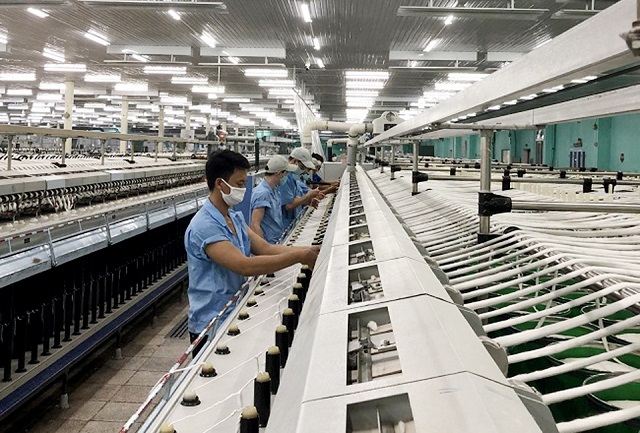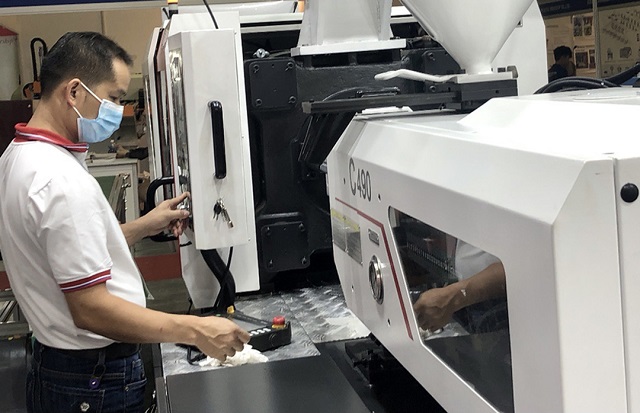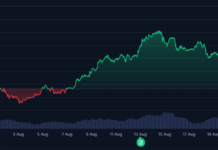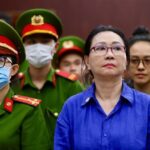
Some textile companies declare raw materials from China but have not yet been subject to the 40% transshipment tax. Illustrative photo: TL
|
Many industries have not yet been subject to the 40% transshipment tax.
The electronics industry is one of Vietnam’s key export sectors, with the United States being the largest market. China remains a significant supplier of components for this industry.
At a recent trade promotion conference, Ms. Do Thi Thuy Huong, a member of the Executive Board of the Vietnam Electronic Enterprises Association, reported that in the first eight months of 2025, the electronics industry’s export turnover exceeded $100 billion, accounting for over 30% of the country’s total export turnover, a 25% increase compared to the same period last year.
According to Ms. Huong, the primary reason for the industry’s high export growth is the favorable U.S. tariffs and new free trade agreements, enabling businesses to capitalize on opportunities during the 90-day tariff grace period. “The volume of containers shipped to the U.S. during this period is the highest,” Ms. Huong shared.
However, since the grace period ended on August 7, businesses have begun facing a 20% import tax in the U.S. Notably, regarding the 40% transshipment tax, Ms. Huong stated that there are no clear guidelines, and no companies have been subject to this tax as of now.
Similarly, Vietnam’s textile industry, which primarily imports fabric and yarn from China, has seen no exporters from the Ho Chi Minh City Textile, Garment, and Fashion Association subject to the 40% transshipment tax nearly two months after its implementation. Even companies explicitly declaring raw materials from China have not faced the doubled 20% tax on goods imported from Vietnam.
Mr. Pham Van Viet, Chairman of VitaJean Co., Ltd., reported that the company recently exported three containers of clothing to the U.S., including one container declared with Chinese fabric, but was still taxed at 20%, with no signs of the 40% tax being applied.
Companies in the furniture, plastics, and rubber industries also confirmed they are currently subject only to the 20% tax, not the 40%, even those reliant on raw materials from China.
This is considered good news for Vietnamese businesses, as a 40% tax would be devastating, severely impacting domestic production and competitiveness in the U.S. market.
No room for complacency; businesses must remain cautious
Over two months before the U.S. officially announced a 20% retaliatory tariff on Vietnamese goods, the Trump administration also threatened a 40% tax on transshipped goods to circumvent tariffs. Analysts emphasize that the 40% tax on transshipped goods highlights the importance of product origin verification.
However, the specific definition of “transshipment” remains unclear, particularly regarding the calculation of raw material content or production stages. This ambiguity leaves domestic businesses and foreign investors anxious and unable to accurately predict the impact.
Transshipped goods can be understood as foreign products repackaged or labeled in Vietnam for export to the U.S. without changes in composition or production processes. If classified as “transshipped,” these goods would face the highest 40% tax.
 Vietnamese businesses are concerned about the U.S.’s “pending” status on transshipped goods. Photo: LH
|
However, the criteria for determining transshipped goods remain unclear. Whether 30%, 50%, or 70% of imported components in a product constitutes a violation is uncertain. This lack of clarity increases compliance costs and legal risks, burdening Vietnamese businesses.
To date, many export industries have not been subject to the 40% tax for transshipment violations, which is considered a significant success. Transshipping goods through Vietnam to obtain a “Made in Vietnam” label could severely damage production sectors and undermine the reputation of Vietnamese exporters. This risk also affects other industries, as experts warn that once a company or sector is found in violation, U.S. import authorities will tighten origin verification, trade defense investigations, and tax evasion checks on exporting countries.
Despite avoiding the higher tax, businesses remain anxious and vigilant. Mr. Pham Van Viet of VitaJean expressed concern: “Although the container declared with Chinese raw materials was taxed at 20%, we worry the U.S. might add another 20% later. This would create significant challenges for us, as our importers have already factored in the 20% tax when receiving the goods for sale.”
Similarly, Mr. Nguyen Quoc Anh, Chairman of the Ho Chi Minh City Rubber and Plastics Association, shared: “When exporting to the U.S., our rubber and plastics companies clearly declare the origin of imported raw materials. Currently, the U.S. is clearing goods at the normal tax rate, but it’s uncertain if they will later impose the 40% ‘transshipment’ tax.”
“Not just the rubber and plastics sector, but many other Vietnamese manufacturing and export industries remain unclear about the U.S.’s specific criteria for the percentage of imported raw materials that would classify goods as ‘transshipped,'” Mr. Quoc Anh noted, adding that the ambiguity surrounding “transshipped goods” is a major concern for Vietnamese businesses.
In this context, experts and industry association leaders advise businesses to remain cautious and prepared for changes. Retaliatory tariffs could lead to conflicts and increased non-tariff barriers from the U.S. The heavy reliance on imported raw materials, especially from China, is a weakness for many Vietnamese manufacturing sectors. As the U.S. tightens taxes, businesses must seek alternative sources to minimize cost and supply chain risks.
For instance, the textile industry, which sources 40-50% of its raw materials from China (over 60% for fabric and yarn), is concerned about origin taxes. Although the U.S. has not yet imposed origin taxes, the industry would face significant challenges if it did. Therefore, companies are working to diversify their supply chains and promote localization.
Additionally, this presents an opportunity for Vietnamese businesses to integrate into the global supply chain, leveraging the trend of production shifts and supply source diversification. By doing so, businesses can reduce policy protection risks, enhance domestic capabilities, and engage in higher-value stages of production.
To overcome tariff barriers, businesses must strengthen internal capabilities, control inputs, build strong brands, and establish closed production chains to minimize risks. Experts emphasize that raw material self-sufficiency is no longer just a technical issue but a critical factor in maintaining Vietnam’s export position amid global supply chain fluctuations. Failure to adapt quickly could leave domestic businesses lagging in this fierce competition.
Le Hoang
– 10:00 02/10/2025
Surplus Balance of Payments, Yet Exchange Rates Remain in Turbulent Waters
The balance of payments has shown cyclical improvements, yet pressures on the exchange rate persist due to heightened demand for the US dollar—particularly for debt servicing and capital outflows. The currency outlook for late 2025 will hinge significantly on trade surpluses, remittance inflows, and the global trade environment.
Top 15 Priority Locations Selected by the Ministry of Construction for Social Housing Development
Ho Chi Minh City, Hanoi, Bac Ninh, and 12 other localities have been identified by the Ministry of Construction as key areas for the development of social housing projects.
Sunshine Group Post-Restructuring: Second-Highest Market Cap in Real Estate, Full-Year Profit Projected at VND 14 Trillion, Surpassing Shareholder Meeting Targets
With projected post-tax profits of approximately VND 14,000 billion in 2025, an 18-fold increase from the previous year, Sunshine Group is poised to achieve a breakthrough growth driven by its comprehensive restructuring efforts. This remarkable performance underscores the effectiveness of the Group’s strategic focus on large-scale economic consolidation and ecosystem integration, surpassing all expectations.













































